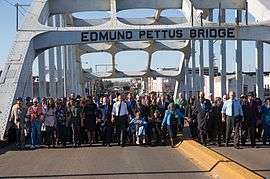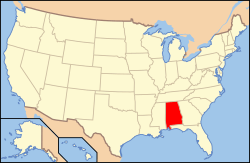Edmund Pettus Bridge
The Edmund Pettus Bridge carries U.S. Route 80 Business (US 80 Bus.) across the Alabama River in Selma, Alabama. Built in 1940, it is named after Edmund Winston Pettus, a former Confederate brigadier general, U.S. senator, and grand dragon of the Ku Klux Klan. The bridge is a steel through arch bridge with a central span of 250 feet (76 m). Nine large concrete arches support the bridge and roadway on the east side.
Edmund Pettus Bridge | |
|---|---|
 The central span of the Edmund Pettus Bridge in April 2010 | |
| Coordinates | 32°24′20″N 87°01′07″W |
Edmund Pettus Bridge | |
| Location | Selma, Alabama, U.S. |
| Built | 1940 |
| Built by | T. A. Loving Company |
| NRHP reference No. | 13000281 |
| Significant dates | |
| Added to NRHP | February 27, 2013[1] |
| Designated NHL | February 27, 2013 |
| Carries | |
| Crosses | Alabama River |
| Characteristics | |
| Design | Through arch bridge |
| Total length | 1,248.1 feet (380.4 m) |
| Width | 42.3 feet (12.9 m) |
| Longest span | 250 feet (76 m) |
| No. of spans | 8 |
| Piers in water | 4 |
| Clearance above | 14.8 feet (4.5 m) |
| History | |
| Construction start | 1939 |
| Construction end | 1940 |
| Opened | May 25, 1940 |
| Statistics | |
| Daily traffic | 17,720 |

| |
The Edmund Pettus Bridge was the site of the conflict of Bloody Sunday on March 7, 1965, when armed police attacked and brutally beat Civil Rights Movement demonstrators with horses, billy clubs, and tear gas[2] as they were attempting to march to the state capital, Montgomery. The marchers crossed the bridge again on March 21 and successfully walked to the Capitol building.
The bridge was declared a National Historic Landmark on February 27, 2013.[1][3]
Design
The bridge carries four lanes of U.S. Route 80 Business over the Alabama River, from Selma on the west side, to points east. The bridge has a total of 11 spans. It has 10 smaller concrete spans, while the main span in the center, over the river, is made of steel. Because Selma is built on a bluff over the river, the west side of the bridge is higher than the east side. The center of the bridge is 100 ft (30 m) over the river. In 2011, the bridge was listed as functionally obsolete, meaning that it does not meet current design standards for its current traffic load.[4]
The Name
The bridge is named after Edmund Winston Pettus, a lawyer, judge, Confederate brigadier general, head of the Alabama Ku Klux Klan, and U.S. senator.[5]
Because of Pettus's role in supporting slavery and racism, a movement is aiming to rename the bridge. With the 50th anniversary of Bloody Sunday in 2015, a group of college students and others organized a campaign to rename the bridge. Changing the name would require approval from the Alabama Legislature. One proposed alternative name is the John Lewis Bridge, after John Lewis, the civil rights leader who played a prominent role in the Selma to Montgomery marches. An earlier attempt to change the name in 2010 failed. Some Selma residents are opposed, believing that changing the name will do nothing to improve race relations in the country.[6][7]
History
Construction
An earlier bridge was built at the same location in 1885 to carry mule loads of cotton. It was a two-lane wooden swing bridge that had to be opened by hand.[6] The Edmund Pettus Bridge was designed by Selma native Henson Stephenson and opened to traffic in 1940.[4]

Civil rights flashpoint
In 1965, voting rights for African Americans were a contentious issue. In Selma, voting rolls were 99% White and 1% African American, while the 1960 Census found that the population of Alabama was 30% nonwhite .[8][9] In February 1965, state troopers and locals in Marion, Alabama, started an armed confrontation with some 400 African-American unarmed demonstrators. Jimmie Lee Jackson was shot in the stomach, and he died eight days later. As word spread, the case alarmed civil rights activists, including Martin Luther King, Jr. and SCLC's Director of Direct Action James Bevel. Director Bevel strategized a plan for a peaceful march from Selma to the Alabama capitol building in Montgomery, which first required crossing the Pettus bridge leading out of Selma and onto the state highway.[10] Many acts like this one involved killings, and many more involved economic and health problems.[11]
On March 7, 1965, armed police attacked the unarmed peaceful civil rights demonstrators attempting to march to the state capital of Montgomery in an incident that became known as Bloody Sunday. Because of the design of the bridge, the protesters were unable to see the police officers on the east side of the bridge until after they had reached the top of the bridge. The protesters first saw the police while at the center of the bridge, 100 feet above the Alabama River. Upon seeing them, protester Hosea Williams asked his fellow protester John Lewis if he knew how to swim. Despite the danger ahead, the protesters bravely continued marching.[4] They were then attacked and brutally beaten by police and the state troopers on the other side.
Televised images of the attack presented Americans and international audiences with horrifying images of marchers left bloodied and severely injured, and roused support for the Selma Voting Rights Movement. Amelia Boynton, who had helped organize the march as well as participated in it, was beaten unconscious. A photograph of her lying on Edmund Pettus Bridge appeared on the front page of newspapers and news magazines around the world.[12] In all, 17 marchers were hospitalized and 50 were treated for lesser injuries; the day soon became known as "Bloody Sunday" within the African-American community.[13]
Legacy

.jpg)
Since 1965, many marches have commemorated the events of Bloody Sunday. On its 30th anniversary, Rep. John Lewis, former president of Student Nonviolent Coordinating Committee and a prominent activist during the Selma to Montgomery marches, said, "It's gratifying to come back and see the changes that have occurred; to see the number of registered voters and the number of Black elected officials in the state of Alabama to be able to walk with other members of Congress that are African Americans."[14] On the 40th anniversary of Bloody Sunday, over 10,000 people, including Lewis, again marched across Edmund Pettus Bridge.[15]
The 1996 Summer Olympics torch relay made its way across the bridge on its way to the Summer Olympic Games in Atlanta.[16] Andrew Young, a Bloody Sunday organizer who went on to become a U.S. Congressman, Ambassador to the United Nations, and Mayor of Atlanta, carried the Olympic flame across the bridge, accompanied by many public officials in a symbolic showing of the progress of race relations in the Southern United States.[16] When Young spoke at the Brown Chapel A.M.E. Church as part of the torch ceremony, he said, "We couldn't have gone to Atlanta with the Olympic Games if we hadn't come through Selma a long time ago."[16]
In March 2015, on the 50th anniversary of Bloody Sunday, U.S. President Barack Obama, the first African-American U.S. president, delivered a speech at the foot of the bridge and then, along with other U.S. political figures such as former U.S. President George W. Bush and Representative John Lewis, and Civil Rights Movement activists such as Amelia Boynton Robinson (at Obama's side in a wheelchair), led a march across the bridge. An estimated 40,000 people attended to commemorate the 1965 march, and to reflect on and speak about its impact on history and continuing efforts to address and improve U.S. civil rights.[17]
In popular culture
- Bloody Sunday and the events of the Selma to Montgomery marches were re-enacted on the bridge and depicted in the films Selma, Lord, Selma (1999) and Selma (2014).
- At the 2015 Academy Awards singer/songwriters Common and John Legend performed their Academy Award-winning song "Glory", which is featured in the film Selma, on a stage-sized replica of the Edmund Pettus Bridge.
- Marilyn Miller's book, The Bridge at Selma (Turning Points in American History) (1989), describes the repercussions of the events of March 7, 1965, on Edmund Pettus Bridge.[18]
- In the March trilogy (2013-2016), the graphic novel autobiography of John Lewis, Lewis and Martin Luther King's trepidation at crossing of the bridge, and the ensuing confrontation with state troopers, bookend the story as a framing sequence seen in the beginning of Book One and near the end of Book Three.
- "Dear Hate", a collaboration by country singers Maren Morris and Vince Gill, features the lyrics: "Dear Hate, you were smiling from that Selma bridge".
See also



References
- "Edmund Pettus Bridge". National Register of Historic Places Program. National Park Service.
- "We Shall Overcome - Selma-to-Montgomery March". Nps.gov. March 7, 1965. Retrieved October 11, 2017.
- "AMERICA'S GREAT OUTDOORS: Secretary Salazar, Director Jarvis Designate 13 New National Historic Landmarks". US Department of the Interior. Retrieved March 11, 2013.
- O'Neill, Connor (March 6, 2015). "How the Design of a Selma Bridge Became a Metaphor for the Civil Rights Movement". Slate. Retrieved March 12, 2015.
- "PETTUS, Edmund Winston - Biographical Information". Bioguide.congress.gov. July 27, 1907. Retrieved August 22, 2010.
- Peeples, Melanie (March 5, 2015). "The Racist History Behind The Iconic Selma Bridge". All Things Considered.
- Desmond-Harris, Jenee (March 9, 2015). "Inside the fight to strip a KKK leader's name from Selma's Edmund Pettus Bridge". Vox. Retrieved March 11, 2015.
- "Nation: The Central Points". TIME. March 19, 1965. Retrieved August 22, 2010.
- "1960 Census" (PDF). Census.gov. Retrieved March 7, 2017.
- "Nation: The Central Points". TIME. March 19, 1965. Retrieved August 22, 2010.
- "We Shall Overcome - The Cost". Nps.gov. Retrieved August 22, 2010.
- Sheila Jackson Hardy; P. Stephen Hardy (August 11, 2008). Extraordinary People of the Civil Rights Movement. Paw Prints. p. 264. ISBN 978-1-4395-2357-5. Retrieved March 6, 2011.
- Reed, Roy (March 6, 1966). "'Bloody Sunday' Was Year Ago". The New York Times. New York, New York. p. 76. Retrieved March 9, 2015.
- Jet - Google Books. Books.google.com. March 27, 1995. Retrieved August 22, 2010.
- Jet - Google Books. Books.google.com. March 28, 2005. Retrieved August 22, 2010.
- Heath, Thomas (July 1, 1996). "After Three Decades, Selma Sees the Light; Torch Crosses Bridge Between Peace, Violence". Washington Post. Retrieved June 19, 2019.
- Baker, Peter; Fausset, Richard (March 7, 2015). "Obama, at Selma Memorial, Says, 'We Know the March Is Not Yet Over'". The New York Times (March 7, 2015). Retrieved March 10, 2015.
- Miller, Marilyn (June 1, 1989). The Bridge at Selma. Silver Burdett Press. ISBN 9780382068263.
External links
| Wikimedia Commons has media related to Edmund Pettus Bridge. |
- National Voting Rights Museum and Institute, Selma, Alabama
- Historic American Engineering Record (HAER) No. AL-209, "Edmund Pettus Bridge, U.S. Highway 80 spanning the Alabama River, Selma, Dallas County, AL", 6 photos, 1 photo caption page
- 2015 Academy Award song performance upon a stage-sized replica of the bridge on YouTube

